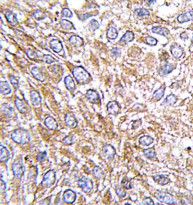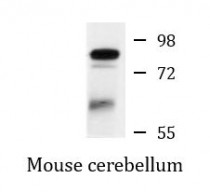ARG59000
anti-GIT1 antibody
anti-GIT1 antibody for IHC-Formalin-fixed paraffin-embedded sections,Western blot and Human,Mouse
Overview
| Product Description | Rabbit Polyclonal antibody recognizes GIT1 |
|---|---|
| Tested Reactivity | Hu, Ms |
| Predict Reactivity | Rat |
| Tested Application | IHC-P, WB |
| Host | Rabbit |
| Clonality | Polyclonal |
| Isotype | IgG |
| Target Name | GIT1 |
| Antigen Species | Human |
| Immunogen | KLH-conjugated synthetic peptide corresponding to aa. 487-517 of Human GIT1. |
| Conjugation | Un-conjugated |
| Alternate Names | G protein-coupled receptor kinase-interactor 1; Cool-associated and tyrosine-phosphorylated protein 1; ARF GTPase-activating protein GIT1; CAT-1; CAT1; GRK-interacting protein 1; ARF GAP GIT1 |
Application Instructions
| Application Suggestion |
|
||||||
|---|---|---|---|---|---|---|---|
| Application Note | * The dilutions indicate recommended starting dilutions and the optimal dilutions or concentrations should be determined by the scientist. | ||||||
| Positive Control | Mouse cerebellum |
Properties
| Form | Liquid |
|---|---|
| Purification | Purification with Protein A and immunogen peptide. |
| Buffer | PBS and 0.09% (W/V) Sodium azide. |
| Preservative | 0.09% (W/V) Sodium azide |
| Storage Instruction | For continuous use, store undiluted antibody at 2-8°C for up to a week. For long-term storage, aliquot and store at -20°C or below. Storage in frost free freezers is not recommended. Avoid repeated freeze/thaw cycles. Suggest spin the vial prior to opening. The antibody solution should be gently mixed before use. |
| Note | For laboratory research only, not for drug, diagnostic or other use. |
Bioinformation
| Database Links |
Swiss-port # Q68FF6 Mouse ARF GTPase-activating protein GIT1 Swiss-port # Q9Y2X7 Human ARF GTPase-activating protein GIT1 |
|---|---|
| Gene Symbol | GIT1 |
| Gene Full Name | G protein-coupled receptor kinase interacting ArfGAP 1 |
| Function | GTPase-activating protein for the ADP ribosylation factor family. May serve as a scaffold to bring together molecules to form signaling modules controlling vesicle trafficking, adhesion and cytoskeletal organization. Increases the speed of cell migration, as well as the size and rate of formation of protrusions, possibly by targeting PAK1 to adhesions and the leading edge of lamellipodia. Sequesters inactive non-tyrosine-phosphorylated paxillin in cytoplasmic complexes. Involved in the regulation of cytokinesis; the function may involve SDCCAG3 and PTPN13 (By similarity). [UniProt] |
| Cellular Localization | Cytoplasm. Note=Cycles between at least 3 distinct intracellular compartments, including focal adhesions, cytoplasmic complexes and membrane protrusions. During cell migration, when cells detach, moves from the adhesions into the cytoplasmic complexes towards the leading edge, while, when cells adhere, it is found in vinculin-containing adhesions. Recruitment to adhesions may be mediated by active tyrosine-phosphorylated paxillin. [UniProt] |
| Calculated MW | 84 kDa |
| PTM | Phosphorylated on tyrosine residues by PTK2/FAK1 and SRC in growing fibroblasts. Tyrosine-phosphorylation is increased following cell spreading on fibronectin, decreased in cells arrested in mitosis and increased in the ensuing G1 phase (By similarity). [UniProt] |
Images (2) Click the Picture to Zoom In







